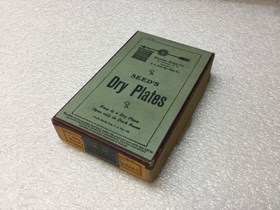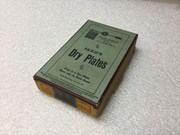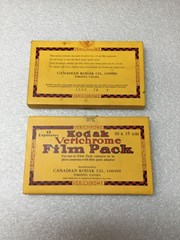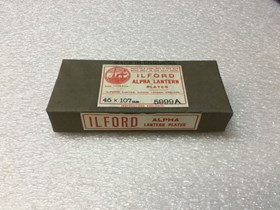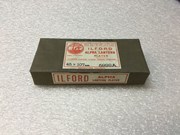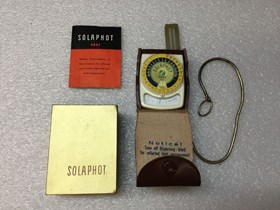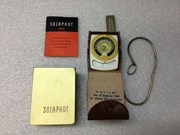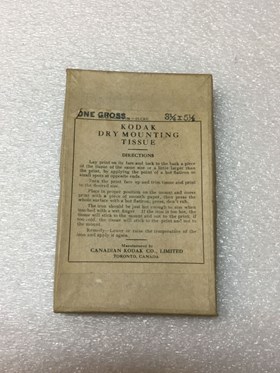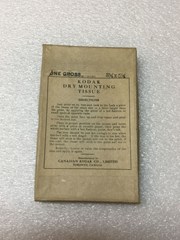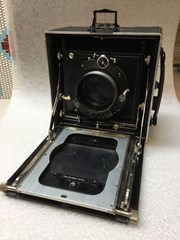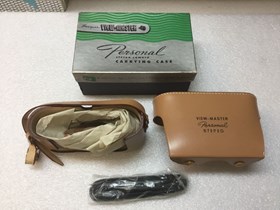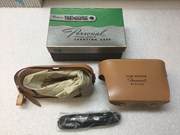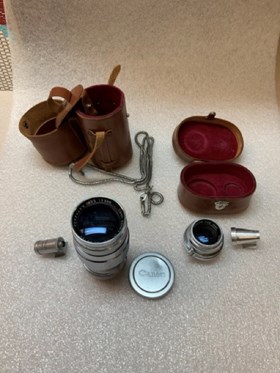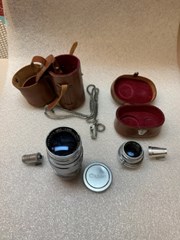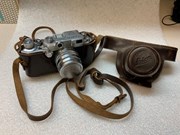Narrow Results By
Exposure Plates
https://archives.whyte.org/en/permalink/artifact104.41.0207
- Date
- 1902 – 1920
- Material
- cardboard; paper; glass;
- Catalogue Number
- 104.41.0207
- Description
- Box of one dozen 3 1/4 x 5 1/2 glass Seed’s Dry Plates with cut paper adhesive tape around the edges and bottom and manufacturer details printed on a pale green background throughout the lid. These dry plates were invented by M.A. Seed in 1879 and became very popular with photographers as the plate…
1 image
- Title
- Exposure Plates
- Date
- 1902 – 1920
- Material
- cardboard; paper; glass;
- Dimensions
- 3.0 x 9.3 x 15.0 cm
- Description
- Box of one dozen 3 1/4 x 5 1/2 glass Seed’s Dry Plates with cut paper adhesive tape around the edges and bottom and manufacturer details printed on a pale green background throughout the lid. These dry plates were invented by M.A. Seed in 1879 and became very popular with photographers as the plates came pre-prepared with the emulsion layer already applied - prior to “dry” plates, photographers would need portable dark rooms in which they would create their liquid emulsions prior to taking a photograph [known as “wet” plates]. Seed’s dry plates still required they be opened in a dark room, but this could be accomplished in the field by placing a dark sheet over the camera while loading and unloading the plates. In 1902, Eastman Kodak purchased Seed’s company [Seed Dry Plate Co.], but continued to capitalize on his name due to its reputation among consumers.
- Credit
- Gift of Robert Crosby Family, Banff, 1998
- Catalogue Number
- 104.41.0207
Images
This material is presented as originally created; it may contain outdated cultural descriptions and
potentially offensive content.
Read more.
- Date
- 1938 – 1945
- Material
- cardboard;
- Catalogue Number
- 104.41.0204 a,b
- Description
- Two boxes of 12 10x15cm Kodak Verichrome Film Packs with broken seals. Each box is mostly yellow with black and red manufacturer and product details throughout - there are two paper adhesive stickers holding the box closed, the one that has the expiration date on it on each box is broken.Verichrome…
1 image
- Title
- Film Pack
- Date
- 1938 – 1945
- Material
- cardboard;
- Dimensions
- 1.4 x 17.9 x 10.9 cm
- Description
- Two boxes of 12 10x15cm Kodak Verichrome Film Packs with broken seals. Each box is mostly yellow with black and red manufacturer and product details throughout - there are two paper adhesive stickers holding the box closed, the one that has the expiration date on it on each box is broken.Verichrome was a kind of panchromatic film that yielded high-quality black and white photographs thanks to the fine-grained emulsion. Film Packs were basic forms of storage meant to be used shortly after purchasing as their [mostly] paper packaging did not keep out oxygen well and had a tendency to fog over time, rendering the film unusable in the long term. It was replaced by the more stable Verichrome Pan in the 1950s.
- Credit
- Gift of Robert Crosby Family, Banff, 1998
- Catalogue Number
- 104.41.0204 a,b
Images
This material is presented as originally created; it may contain outdated cultural descriptions and
potentially offensive content.
Read more.
Lantern Plates
https://archives.whyte.org/en/permalink/artifact104.41.0206
- Date
- 1889 – 1910
- Material
- paper; glass;
- Catalogue Number
- 104.41.0206
- Description
- One paper-wrapped package of 45x107mm Ilford Alpha Lantern Plates with white and red paper adhesive labels on the top and front of the package containing manufacturer details. These lantern plates would serve as the positive mount for the lantern slide made from the original negative. Lantern slide…
1 image
- Title
- Lantern Plates
- Date
- 1889 – 1910
- Material
- paper; glass;
- Dimensions
- 2.0 x 11.6 x 5.3 cm
- Description
- One paper-wrapped package of 45x107mm Ilford Alpha Lantern Plates with white and red paper adhesive labels on the top and front of the package containing manufacturer details. These lantern plates would serve as the positive mount for the lantern slide made from the original negative. Lantern slides are glass-based transparencies that were displayed by being projected through an early projector called a magic lantern. Starting as hand-painted images on glass, lantern slides quickly adapted to first black-and-white and then colour photography and faded from popularity with the rise of celluloid film and motion pictures.
- Credit
- Gift of Robert Crosby Family, Banff, 1998
- Catalogue Number
- 104.41.0206
Images
This material is presented as originally created; it may contain outdated cultural descriptions and
potentially offensive content.
Read more.
- Date
- 1960 – 1986
- Material
- cardboard; metal; glass;
- Catalogue Number
- 104.41.0197
- Description
- Small round silver metal 5 cm camera lens attachment with small horizontal runners that slide into the base on the tops of most cameras. This lens is most likely a specifically-adjusted sight for a larger lens, based on the small size and the presence of a black rectangle printed on the glass of th…
1 image
- Title
- Lens
- Date
- 1960 – 1986
- Material
- cardboard; metal; glass;
- Dimensions
- 2.6 x 3.8 x 4.4 cm
- Description
- Small round silver metal 5 cm camera lens attachment with small horizontal runners that slide into the base on the tops of most cameras. This lens is most likely a specifically-adjusted sight for a larger lens, based on the small size and the presence of a black rectangle printed on the glass of the lens.The box consists of a white cardboard body with a partially torn housing inside for the lens that slides horizontally into a green cardboard sleeve. The green section has a narrow strip of adhesive tape around it, blocking most of the text on both the top and bottom - a small white rectangular price tag with “10.20” written on it in blue ink also obscures the text on the box.
- Credit
- Gift of Robert Crosby Family, Banff, 1998
- Catalogue Number
- 104.41.0197
Images
This material is presented as originally created; it may contain outdated cultural descriptions and
potentially offensive content.
Read more.
- Date
- 1957 – 1957
- Material
- cardboard; paper; leather; metal; plastic;
- Catalogue Number
- 104.41.0196
- Description
- White plastic light meter with a central metal dial above a clear plastic window over the meter needle and a removable metal grate over the light-sensitive plate on top housed in a brown leather pouch with “SOLEPHOT” embossed in gold on the front. The leather pouch snaps closed over the top at the …
1 image
- Title
- Light Meter
- Date
- 1957 – 1957
- Material
- cardboard; paper; leather; metal; plastic;
- Dimensions
- 3.5 x 6.3 x 8.4 cm
- Description
- White plastic light meter with a central metal dial above a clear plastic window over the meter needle and a removable metal grate over the light-sensitive plate on top housed in a brown leather pouch with “SOLEPHOT” embossed in gold on the front. The leather pouch snaps closed over the top at the back and has a small opening in the bottom through which a gold metal chain is attached to the bottom of the meter. The meter is housed in its original cardboard box, which consists of a gold lid with “SOLAPHOT” printed in red on the lid that fits completely over the white body - also inside the box is the paper instruction manual.
- Credit
- Gift of Robert Crosby Family, Banff, 1998
- Catalogue Number
- 104.41.0196
Images
This material is presented as originally created; it may contain outdated cultural descriptions and
potentially offensive content.
Read more.
Mounting Tissue
https://archives.whyte.org/en/permalink/artifact104.41.0205
- Date
- 1930 – 1950
- Material
- cardboard;
- Catalogue Number
- 104.41.0205
- Description
- Plain cardboard box of 3 1/4 x 5 1/3[?] Kodak Dry Mounting Tissue held closed with a long strip of paper adhesive wrapped over the lid to the bottom of the box and a paper adhesive label on the lid displaying the manufacturer and direction of use details. Dry Mounting Tissues were a kind of adhesiv…
1 image
- Title
- Mounting Tissue
- Date
- 1930 – 1950
- Material
- cardboard;
- Dimensions
- 1.7 x 10.2 x 15.0 cm
- Description
- Plain cardboard box of 3 1/4 x 5 1/3[?] Kodak Dry Mounting Tissue held closed with a long strip of paper adhesive wrapped over the lid to the bottom of the box and a paper adhesive label on the lid displaying the manufacturer and direction of use details. Dry Mounting Tissues were a kind of adhesive used to attach a print to a support or mount [like card stock, cardboard, wood, foam core, etc] that is activated by heat and pressure. A smooth piece of paper would be laid over the print, with the tissue between the print and the support, and then a hot iron would be pressed over the whole area, melting the tissue and activating the glue. Once cool, the glue was set.
- Credit
- Gift of Robert Crosby Family, Banff, 1998
- Catalogue Number
- 104.41.0205
Images
This material is presented as originally created; it may contain outdated cultural descriptions and
potentially offensive content.
Read more.
- Date
- 1889 – 1945
- Material
- metal; glass; leather;
- Catalogue Number
- 104.41.0181
- Description
- Black leather and silver metal 4x6 Curt Bentzin Görlitz camera with a fold-down front panel that exposes the lens and bellows, a leather handle and two adjustment knobs on one side, a pop-up view finder on top, and fold-out leather flaps that access the exposure plate. Small metal levers throughout…
1 image
- Title
- Camera
- Date
- 1889 – 1945
- Material
- metal; glass; leather;
- Dimensions
- 19.7 x 20.0 x 14.4 cm
- Description
- Black leather and silver metal 4x6 Curt Bentzin Görlitz camera with a fold-down front panel that exposes the lens and bellows, a leather handle and two adjustment knobs on one side, a pop-up view finder on top, and fold-out leather flaps that access the exposure plate. Small metal levers throughout allow different panels in the camera to open - three holes along the bottom [one on the body of the camera and two on the fold-down lens plate] allow the camera to be mounted on a tripod.
- Subject
- Crosby family
- Abegweit
- cameras
- photography;
- Credit
- Gift of Robert Crosby Family, Banff, 1998
- Catalogue Number
- 104.41.0181
Images
This material is presented as originally created; it may contain outdated cultural descriptions and
potentially offensive content.
Read more.
- Date
- 1952 – 1952
- Material
- cardboard; paper; plastic; leather; metal;
- Catalogue Number
- 104.41.0188
- Description
- View-Master Personal Stereo Camera leather carrying case in the original box - the case has never been used. The carrying case is made of tan-coloured leather and consists of two pieces that snap together with three small metal snaps - two on the bottom and one at the back. Also on the bottom is a …
1 image
- Title
- Camera Case
- Date
- 1952 – 1952
- Material
- cardboard; paper; plastic; leather; metal;
- Dimensions
- 7.9 x 12.5 x 19.6 cm
- Description
- View-Master Personal Stereo Camera leather carrying case in the original box - the case has never been used. The carrying case is made of tan-coloured leather and consists of two pieces that snap together with three small metal snaps - two on the bottom and one at the back. Also on the bottom is a large silver metal screw that attaches the case to the camera. The interior of the case is stuffed with packing paper and has an extra tan strap rolled up in the middle - an additional black leather strap in a plastic sleeve is also included. The box consists of a patterned maroon body with a silver and green lid.
- Credit
- Gift of Robert Crosby Family, Banff, 1998
- Catalogue Number
- 104.41.0188
Images
This material is presented as originally created; it may contain outdated cultural descriptions and
potentially offensive content.
Read more.
- Date
- 1950 – 1955
- Material
- leather; fabric; velvet; metal; glass;
- Catalogue Number
- 104.41.0192 a,b
- Description
- Two Canon camera lenses in leather cases. The larger one is a f:3.5 135mm lens with lens caps on both ends in a brown leather carry case along with its 135mm viewfinder attachment. The leather case is lined with red velvet - the lens sits in the main body and in the lid is a false-bottom compartmen…
1 image
- Title
- Camera Lenses
- Date
- 1950 – 1955
- Material
- leather; fabric; velvet; metal; glass;
- Dimensions
- 13.6 cm
- Description
- Two Canon camera lenses in leather cases. The larger one is a f:3.5 135mm lens with lens caps on both ends in a brown leather carry case along with its 135mm viewfinder attachment. The leather case is lined with red velvet - the lens sits in the main body and in the lid is a false-bottom compartment that houses the viewfinder - the cap hinges off on a short strip of leather and snaps closed. Looped through the leather carry strap is a long metal chain held closed with a clasp.The smaller one is a f:2.8 35mm lens with only one lens cap in a brown leather case along with a Braun f=38mm viewfinder attachment. The leather case is line with red velvet with indented cut-outs for the lens and the viewfinder in the main body - the lid hinges back on a small piece of leather and has a small clasp on the front.
- Credit
- Gift of Robert Crosby Family, Banff, 1998
- Catalogue Number
- 104.41.0192 a,b
Images
This material is presented as originally created; it may contain outdated cultural descriptions and
potentially offensive content.
Read more.
- Date
- 1951 – 1951
- Material
- leather; metal; glass;
- Catalogue Number
- 104.41.0191
- Description
- Black and silver metal Canon IV camera in a dark brown leather case. The camera is fit with a f:1.8 50mm lens and has a short leather strap attached to both short sides underneath the leather case. The case has “Leica” stamped on the front of the lens cover, snaps closed at the back, has a large si…
1 image
- Title
- Canon Camera
- Date
- 1951 – 1951
- Material
- leather; metal; glass;
- Dimensions
- 8.8 x 10.0 x 15.0 cm
- Description
- Black and silver metal Canon IV camera in a dark brown leather case. The camera is fit with a f:1.8 50mm lens and has a short leather strap attached to both short sides underneath the leather case. The case has “Leica” stamped on the front of the lens cover, snaps closed at the back, has a large silver metal screw on the bottom that attaches to the camera, and has a long thin leather strap that could be hung around the neck.
- Subject
- Crosby family
- Abegweit
- cameras
- photography;
- Credit
- Gift of Robert Crosby Family, Banff, 1998
- Catalogue Number
- 104.41.0191
Images
This material is presented as originally created; it may contain outdated cultural descriptions and
potentially offensive content.
Read more.

